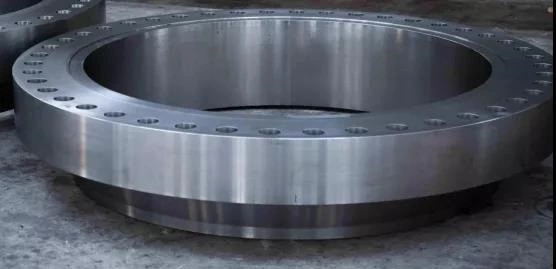Large-diameter flange anti-corrosion construction & characteristics
Large-diameter flanges are widely used in machinery, chemical industry, wind power, sewage treatment and other industries, and are well received and favored by users. Large-diameter flanges are widely used. The production technology of large flange is divided into rolling and forging. Extra large flanges can only be rolled, and the materials are carbon steel, stainless steel and alloy steel. The different performances of flange fittings in different fields have good product performance, adapt to different occasions and spaces, and their effects are also different.

Assembly principle and requirements of large diameter flange
1. For the assembly of companion flanges, the bolt holes for installing flange should be aligned with the corresponding bolt holes for flange fixing and parallel to the fixed flange. The deviation shall not be greater than 1.5‰ of the outer diameter of the flange and not greater than 2mm.
2. Use a 90° angle ruler to check and correct the position of the flange from the left and right directions, perform spot welding after the third and fourth points, and complete the spot welding and fixing of the flange.
3. When selecting matching flanges for equipment or valve parts, pay attention to whether the flanges of the original equipment or valve parts are consistent with the flange connection dimensions used in the pipeline.
4. When assembling the slip on flange, insert the pipe end into 2/3 of the thickness of the inner diameter of the flange, then spot weld the flange to the pipe. If it is a horizontal pipe, it should be spot welded from above, and then check and correct the flange position from different directions with a 90° angle ruler. Make the sealing surface perpendicular to the center line of the pipe, and then perform spot welding below the welding point.
5. Before assembling the flange, clean the flange surface, especially the sealing surface.
Anti-corrosion construction process and characteristics
Fill the gap of large-diameter flange with sealing corrosion inhibitor. Paste paper (transparent) tape on the outer edge of the flange to prevent the outer edge from being dirty when the corrosion inhibitor is injected into the flange; seal and fill the flange gap with the corrosion inhibitor to ensure that the flange gap is fully filled with the sealing corrosion inhibitor.
After filling the flange gap with corrosion inhibitor, use a putty scraper to smooth the surface in the circumferential direction so that the gap and the flange edge are on the same plane. Tear off the paper tape on both sides.
If you use flange anti-corrosion paste, you need to use a knife to cut the flange anti-corrosion paste into a narrow strip, according to the width of the flange gap, and then directly fill the flange gap by hand.
Large-diameter flange clearance and surface treatment. Use a brush to remove floating rust on flange clearance and screws; use compressed air to clean the flange clearance; if chemical rust remover is used, evaluate whether the chemical rust remover will affect the flange seal.
If you are not sure, it is recommended not to use chemical methods; wipe the flange surface with sandpaper or cotton yarn to meet the requirements of the ST2 standard.
Wrap outer protective tape (choose according to the situation). According to the location, choose the outer protective tape of the corresponding color; choose the outer protective tape with a width of 50 mm or 100 mm according to the width of the flange; wrap one ring of outer protective tape around the anti-corrosion tape, and pay attention to leaving 2-3mm wide anti-corrosion tape on both sides of the outer tape when winding.
Wrap anti-corrosion tape. If the flange width is 50~100 mm, use 50 mm×5m anticorrosion tape; if the flange width is greater than 100 mm, use 100 mm×10m anticorrosion tape; wrap a whole circle of anticorrosion tape, without axial displacement directly exceeding the flange gap, and overlap 100 mm at the end.
If the width of the anti-corrosion tape is smaller than the width of the flange, and the corrosion of the flange must be prevented, wrap anti-corrosion tape on both sides until the outer edge of the flange is covered by the anti-corrosion tape.
Related News
- Low-Temperature Flange Sealing Solutions for Cryogenic Chemical Pipelines
- Innovative Technology for Automatic Alignment in Underwater Flange Assembly
- Stamped Steel Slip-On Flanges
- Design and Finite Element Analysis of Anchor Flanges for Oil & Gas Pipelines
- Forming and Manufacturing Technology of Anchor Flanges
- Structure and Materials of Anchor Flanges
- Flanges for Pressure Vessels
- An Introduction to Socket Welded Neck Flanges
- Heat Treatment & Mechanical Properties of ASTM A350 LF3 Flanges (Part Two)
- Heat Treatment & Mechanical Properties of ASTM A350 LF3 Flanges (Part One)

